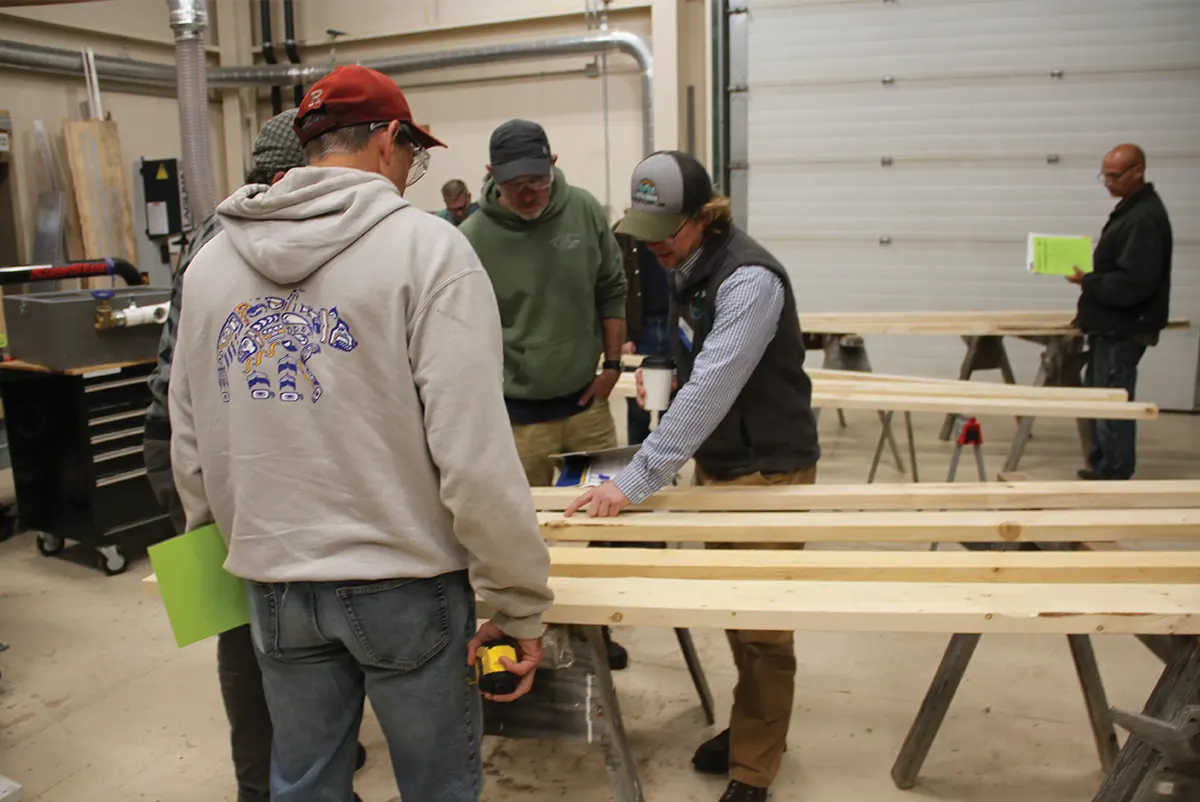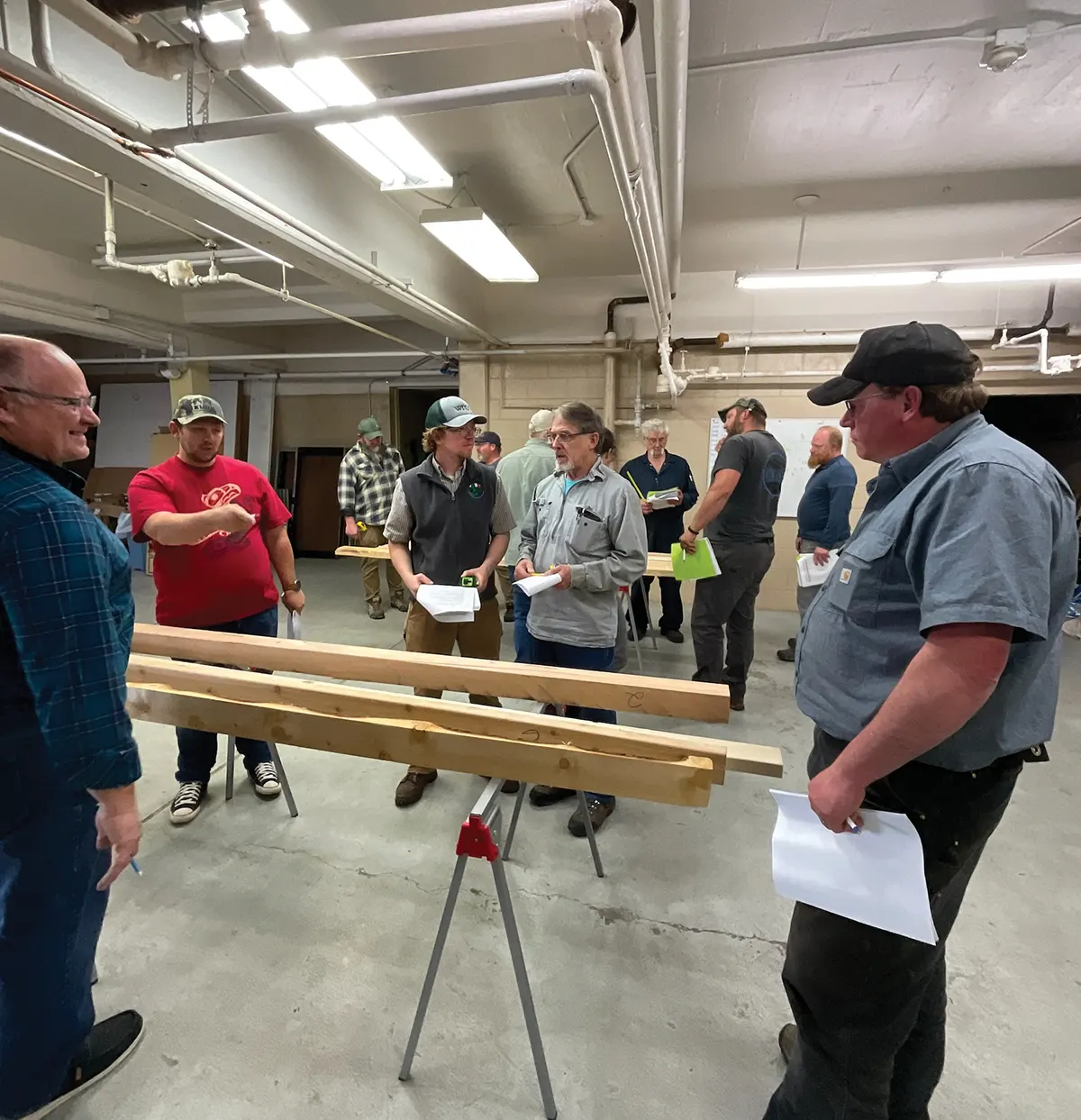raining and certifying Alaskans to self-grade dimensional lumber opens a new opportunity to provide a product to the local residential construction market.
“The product can be sold to an end-user and used in structural applications in houses and frames that meet residential building code requirements where applicable,” says Matt Labrenz, a forest products specialist for the UAF Cooperative Extension Service (CES).
Currently, there aren’t any Alaska mills comparable in size and scale to the industrial mill operations in the major lumber producing regions of North America. Large mills usually belong to a grading agency that grades and marks lumber produced by these mills and ensures lumber meets quality control standards.
Since the decline of Southeast sawmills in the ‘90s, a couple of smaller Alaska mills provide grade-stamped lumber, but most remaining mills don’t. With training and certification, though, they could.
The ALG program is designed to allow sawyers to self-grade dimensional lumber, which may be accepted as an alternative for lumber identified by a grade mark that satisfies building code requirements in Alaska. The program is meant to help get local sawmill products to market and reduce Alaska’s dependence on lumber shipped from Canada and the Pacific Northwest. Ultimately, the goal is to create more demand for locally produced dimensional lumber and more economic opportunities for mill owners and loggers.
“We are not trying to replace the product provided by grading agencies,” says Jeremy Douse, deputy director of forestry at the Alaska Department of Natural Resources Division of Forestry & Fire Protection (DOF). “In fact, we hope that small businesses grow out of this program and become members of the grading agencies.”
The ALG program allows local builders to fully benefit from the timber resource in this state.
In addition, Douse says the ALG program increases forest management opportunities. Alaska DOF is the state’s forest and timber manager. The Fire Protection branch is responsible for wildfire response, and the Forestry branch is responsible for timber production, timber sales, and management of forest resources. Together these two branches work to develop, conserve, and enhance Alaska’s forests to provide a sustainable supply of forest resources for Alaskans. Douse says the ALG program allows Alaskans to benefit from natural timber resources while maintaining diversity in forest stand conditions and addressing forest health and wildfire risk around communities.
“The ALG program helps both situations by creating an environment where small businesses can purchase logs from loggers, make a value-added product, and sell it to a contractor or individual for home construction,” says Douse.
UAF Cooperative Extension Service

In 2023, state Senator Jesse Bjorkman of Nikiski introduced SB87. After SB87 passed, DOF partnered with UAF CES, which has expertise in delivering educational programs, to build the specifics of the class. As part of its mission, UAF CES provides a link between the university and Alaska’s communities by interpreting and extending research-based knowledge in a usable form to the public.
“The training is designed to accommodate various learning styles,” says Labrenz. “The most technical part of the training is understanding and applying the grading rules. The information is presented through lecture, text, illustrations, discussions, and hands-on practice.”
Program certification covers softwood species, including Alaska yellow cedar, western hemlock, Sitka spruce, and white spruce. These Alaska species were tested by the Ketchikan Wood Technology Center in conjunction with a grading bureau to determine strength properties. The results were submitted to the American Lumber Standard Committee, Inc. which formally approved the design values for these species.
The scope of ALG is limited to three commonly used dimensional lumber grades relevant to residential construction that correspond (but are not equal or identical) to lumber grades established by accredited grading bureaus. The limiting characteristics for each grade are closely based on those developed and maintained by an accredited grading bureau; in some instances, they are more restrictive. In effect, this simplifies learning and applying the grading system and reduces the chance of errors.
Additionally, the course covers all the details and rules associated with participating in the program, such as documentation requirements. There are no prerequisites for the ALG program, but Douse says it’s helpful if participants have some experience in running a sawmill and some familiarity with structural lumber and building principles. He says small mill owners and loggers will benefit most from the training. Likewise, everyone involved hopes that small and rural communities will benefit through increased economic activity and additional home construction.
UAF Cooperative Extension Service

Though the ALG program is one step closer to bringing local forest products to market, Douse says there are still other challenges on the horizon. Residential building codes are managed at the municipal level, which can lead to inconsistencies of material requirements. Some communities have a residential building code, usually the 2021 International Residential Code, that requires the use of grade-stamped lumber, but other communities don’t adhere to this specification. Likewise, funding agencies such as the Alaska Housing Finance Corporation (AHFC) use the international code as their minimum construction standards.
“The AHFC has acknowledged the ALG program and made an amendment to its minimum construction standard to allow for dimensional lumber provided by this program,” says Douse. “It is our hope that municipalities with residential building codes start making amendments to their codes to allow for this product as well.”
In January, Bjorkman introduced a separate bill to establish a statewide residential building code, but the legislation (and its counterpart in the Alaska House) did not progress before the session ended.
ALG cannot bring back the heyday of the Alaska lumber industry, nor was SB87 meant to. But by equipping small sawmill operators to supply the materials that local builders need, the program puts multiple industries on a firmer foundation.